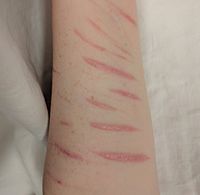
Photo from wikipedia
Despite the high prevalence of self-harm among young people, as well as their extensive use of mobile apps for seeking support with their mental healthcare, it is unclear whether the… Click to show full abstract
Despite the high prevalence of self-harm among young people, as well as their extensive use of mobile apps for seeking support with their mental healthcare, it is unclear whether the design of mobile apps aimed at targeting self-harm is underpinned by behavior change techniques (BCTs). To systematically analyze and identify (a) what BCTs and (b) what theories are present in self-harm apps for young people in an attempt to understand their active components. Systematic searches in Apple store, followed by thorough screening, were conducted to identify free mobile apps targeting self-harm in young people. Five apps met the inclusion criteria and were used by trained researchers, who coded identified features against the BCT Taxonomy V1. Despite the majority of apps being underpinned by principles of Dialectical Behavior Therapy (DBT), no other information is available about specific theories underpinning these apps. Nineteen of the 93 BCTs were identified across the five apps. The most frequently used BCT was "Distraction" (54.2%), offering ideas for activities to distract users from self-harming. Other techniques that were used often were "Social Support (unspecified)" (27.0%) and "Behavior Substitution" (10.6%). This study provides the first analysis of BCTs present in mental health apps which are designed to target the reduction of self-harm in young people. Future research is needed to evaluate the effectiveness of the apps, as well as assess the effectiveness of the BCTs present.
Journal Title: Translational behavioral medicine
Year Published: 2021
Link to full text (if available)
Share on Social Media: Sign Up to like & get
recommendations!